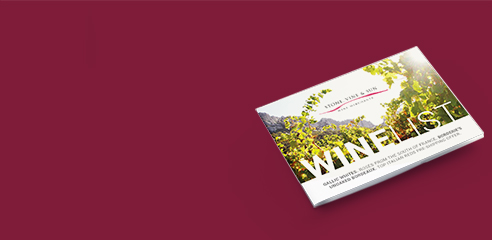SEEKING VALUE
30th September 2022
Ever since Stone, Vine & Sun was founded in 2002 we have focussed on value above all else. I had been buying wine as a wine drinker for over twenty five years before starting the business so simply carried forward my consumer’s search for that elusive price-quality ratio to buying wine for SVS. When tasting, we simply ask whether we, as wine drinkers, would enjoy this wine for £XX?
However certain buying strategies can help – so here is our insider guide to seeking value in wine (and you can also see what we don’t pay any attention to at the foot of this article).
Absolute Value
In any good wine importer’s stock there will be a handful of wines, often a little off-beat, which stand out as offering extraordinary value. They over-deliver, usually vintage after vintage. It may be hard to identify these but a high proportion will come from certain countries or regions, notably:
Such an exciting country for wine – it’s not really a new world country as the first harvest there was in the 1650s; and recently winemakers have been celebrating the heritage of old vines, not just Chenin Blanc but Grenache Blanc, Cinsault and Grenache Noir. Now it offers everything, from Sauvignon Blanc, Chardonnay, Chenin and superb white blends (arguably the Cape’s greatest strength) to vastly improved reds, from the Bordeaux styles which were the summit of the industry last century to fine Syrah/Shiraz and Pinot Noir today. Other factors in delivering value are a currency which is as weak or weaker than sterling, low labour costs (so more vineyard work in particular can be done by hand) and relatively cheap container shipping (as the wineries are all close to the port of Cape Town). All in all it’s a winner.
As Christine Keeler would note, we would say this as we have specialised in the region for twenty years and offer one of the best ranges in the country. But we stock these wines because we have built a loyal following for them and sell bucketloads. In France the Languedoc-Roussillon is given equal status to other classic regions because it has so many strengths. First, it’s an enormous zone, the largest contiguous grape growing region in the world: if it was a separate country it would be the sixth largest wine producer in the world. Secondly, the Mediterranean climate is near perfect for grape growing, with negligible frost threat, perfect sunshine almost every summer and plenty of wind to promote grape health (so it’s easy cultivate the vines organically). Thirdly, there has been minimal price inflation in recent years – much less than in nearby southern Rhône, for example. Land values also remain reasonable, enabling ambitious young growers to buy land and start making wine. Fourth, there is superb land: from the schistous slopes of Faugères or Roussillon, the plateau of the Terrasses du Larzac, or the limestone klippen of La Clape, there are truly great sites which deserve to be better known here.
Regional Italy
We continue to develop our Italian portfolio. Fifteen years ago our impression was that Italian wine felt expensive in the UK – and many wines from Piedmont and Tuscany still are. None of us spoke Italian so we struggled to do the same off the beaten track prospecting on the road that we could do in France, Spain or South America – I remember one excruciating tasting with a Tuscan grower I had tracked down from drinking his wine in a local restaurant when he couldn’t speak a word of English and I couldn’t manage a word of Italian! But now the younger English-speaking generation have taken over it’s a different story and we add one or more Italian estates every year. There’s been far less inflation, even in the classic regions, than France; and the best values can often be found away from the more famous DOCs, for example in Emilia-Romagna or the Marche.
Out of Fashion
A region’s reputation can be damaged, almost irretrievably in some cases, by a number of factors: for example poor winemaking a generation ago; or, all too often, over-production to meet the demands of supermarket price points rather than any quality standard. Being out of fashion depresses prices and enables canny drinking. Examples are:
Muscadet
Are you old enough to remember battery acid supermarket Muscadet? This region on the Atlantic coast became so out of fashion that about a quarter of the growers just gave up in the early years of this century. By contrast the growers who are left have to focus on quality to sell their wine – for example someone like Jeremie Huchet who has assembled a number of estates to make excellent wines at reasonable prices.
Whilst prices for Burgundy rocket, those for neighbouring Beaujolais remain so reasonable. The region suffers terribly from being out of fashion, and I would put a lot of that down to the former craze for poor quality Beaujolais Nouveau which left a legacy of mistrust of the name. One grower we used to work with took the word “Cru de Beaujolais” off his Morgon labels to avoid any negative association! Cru Beaujolais (from the ten named villages) today is juicy and joyous – and whilst it is often more immediately pleasurable than red Burgundy costing a lot more, it also ages really well too. The wines have also benefited from climate change, showing higher levels of ripeness and concentration.
White Bordeaux is so often forgotten or underrated: the unoaked wines arguably represent better value than Loire Sauvignon Blanc; and the oaked examples represent an excellent alternative to increasingly expensive white Burgundy.
A huge appellation which has become dominated by a couple of enormous co-operatives. Whilst their production is often disappointing, there are many small estates making super wine, especially in the mountainous Hautes Corbières in the south.
Soave
As with Muscadet, the supermarkets trashed the reputation of Soave. The pergola-trained vines of the region - unusually in Europe - may be irrigated, which might explain why so many Soaves taste watery. The real deal, in particular from diligent growers with vines in the heartland of volcanic hills, can be deliciously good value.
Bardolino & Valpolicella
A pair of neighbouring wine regions between Verona and Lake Garda, making mostly (excluding Ripasso, Riserva and Amarone styles) light reds from Corvina and other local grapes. These were widely available in the 1980s, but too many dilute, barely ripe examples undermined the brands.
Spain seems generally out of fashion to me – and rightly so for much of its red production, spoiled by a lack of freshness, poor quality oak treatment and excessive alcohol. But, counter intuitively, Spanish whites (bar the fashionable Albarino) are often under-appreciated, and whether from Galicia, Catalonia or Valencia, can offer excellent value.
The "Just Off" Principle
This isn’t rocket science. If you can’t afford X then try looking nearby for wines made from the same grapes. Here are four examples.
If you would like to drink Barolo and Barbaresco but feel daunted by the prices, then consider Langhe Nebbiolo.
The Loire vineyards were badly hit by frost in the spring of 2021. If you don’t wish to pay increased prices for Sancerre or Pouilly-Fumé then a crisp Touraine Sauvignon is your best bet.
Graves
Next to Pessac-Léognan, home to Haut-Brion amongst others, is Graves, named after the ancient river gravels, the distinguishing terroir of the left bank of Bordeaux. This is the source of some super wines at a fraction of the price of the classified growths.
Mâconnais
As white burgundy from the Côte de Beaune leaps in price, look south. The northern Mâconnais, in particular the vineyards in and around Viré-Clessé, can produce strikingly smart Chardonnays.
Substitutes
As old world classics have become more and more expensive, then look for substitutes, particularly in the new world. This is particularly relevant to Chardonnay and Pinot Noir, the fashionable and sought after grapes of Burgundy.
White Burgundy – there are excellent barrel-fermented Chardonnays to be found in Australia (especially Yarra Valley and Adelaide Hills), Chile (cool coastal sites) and South Africa (notably Hemel-en-Aarde). Wines from these zones can rival all but the finest Grand Cru Burgundy.
Red Burgundy – for top quality Pinot Noir look to Australia (Yarra Valley again), New Zealand (and not just fashionable Central Otago but Marlborough and Martinborough too), Chile (cool coastal sites again) and the Vipava Valley in Slovenia. California and Oregon are also great sources, although not at autumn 2022s exchange rate (see below)!
The Benefits of Climate Change
Many of the northern European vineyards have benefited from climate change over the last decades. There are losers too – notably Spain (see above) and the southern Rhône, where very hot and dry summers have brought low yields, stewed Syrah and excessive levels of alcohol amongst the Grenache.
It may seem odd to include Bordeaux in any survey of seeking value but there are really two discrete wine markets in Bordeaux. In one, inhabited by a few score Châteaux, a number of real consumers (notably in the USA, Europe and Asia) and a pile of investors/speculators, prices for classic wines have risen alarmingly. Back in the real world, which we happily inhabit, the vast majority of red wine from Bordeaux has become much more consistently enjoyable, in large part due to warmer summers in this Atlantic-influenced climate. Now they can ripen good volumes of high-quality grapes almost every year - notable exceptions being 2002, 2007, 2013 and 2017. Has the quality of Bordeaux Rouge ever been better than in the sunny 2019 and 2020 vintages?
Northern Burgundy
As vignerons in the Côte d’Or struggle with ever increasing temperatures, it’s obvious that further north, in outlying historic pockets of vineyards, Chardonnay and Pinot Noir are ripening perfectly in a more classical manner. Historically Auxerre had flourished as a wine producing area, due to the ease of shipping down the Yonne to Paris, until phylloxera laid waste its vineyards in the late 19th century. So seek Chardonnays from the tiny appellation of Vezelay and Tonnerre and Pinot Noirs from the beautiful amphitheatre of Irancy.
Others
Loire Cabernet Franc: Prior to the 1990s one only saw good vintages for Cabernet Franc in the middle Loire (appellations of Chinon, Saumur-Champigny, Bourgeuil and St. Nicolas de Bourgeuil) perhaps two years in five; now it’s probably five out of six, and even simple Anjou Rouge can be delicious.
German reds: especially Pinot Noir, but also Syrah.
Currency Opportunities
Right now (October 2022) the pound has lost out against almost every currency in the vine growing world - bar the South African rand. But there are occasional opportunities in the movement of currencies.
As an example, the 30 year average of the pound to the $US is 1.60. Believe it or not, back in the spring of 2008 the pound peaked at over two dollars. I rushed out to the West Coast and that year we started working with three estates in Oregon and three in Washington State. The wines we shipped - from Oregon Pinot Noir and Pinot Gris to Washington State Cabernet and Syrah - were splendid and offered great value. By contrast, today the pound buys just $1.10 and we couldn’t begin to sell those same wines now. Boy, am I glad right now that SVS isn’t a USA wine specialist.
A less extreme example is related to fluctuations in the Australian dollar against sterling. For most of the last decade the Australian currency was supported by its mineral wealth and in particular by a huge export trade with China. (When I visited in 2017 I couldn’t believe how expensive everything was – until I realised it was all relative and the average wage in Australia was 70% more than the UK). However, after that relationship hit the rocks - and the Chinese authorities began making it near impossible for Australian producers to export there - the currency became softer and the wines correspondingly better value here.
Finally, to avoid…..
This is what we don’t pay any attention to:
Reputations. The craze over the last decade has been the elevation of certain Burgundy winemakers to god-like status. They do make great wines - but are their wines really worth 3-6 times as much as their neighbours? Are the prices driven more by excessive global demand and short supply than intrinsic worth? Super Tuscans were hugely in fashion a decade ago – but whilst a few great estates continue to make wonderful wine, many others who jumped on the Cabernet/Merlot bandwagon have given up – the reality didn’t match the hype and statement pricing and the consumers saw through them.
Expensive bottles and packaging. Think of the absurdly fancy designs of certain Provence rosés or the gross heavyweight bottlings of some South American trophy wines. These add real costs to your drinking!
And now…..Social media profiles. Depressingly social media presence is one of the factors being used to measure the classification of St. Emilion estates. (Can you believe that from 2012 to 2022 - now partly rectified - only 30% of the marks given in the official classification was for the actual wine, with the other 70% scored for digital activity, infrastructure (tasting rooms, Châteaux) etc.? By contrast I was amused to see Leoville-Barton, home to several of Bordeaux’s best value top wines, did not appear at all in a ranking of the top 30 Bordeaux Châteaux for digital and social media activity!



